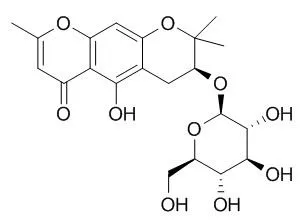| In vitro: |
| 2014 International Symposium and Annual Meeting, 2014.10, 338-338. | | Anti-Inflammatory Effect of Sec-O-glucosylhamaudol from Ledebouriella seseloides through Regulation of p38 Mitogen-Activated Protein Kinase in Lipopolysaccharide-Stimulated RAW264.7 Cell Line[Reference: WebLink] | | Anti-Inflammatory Effect of Sec-O-Glucosylhamaudol from Ledebouriella seseloides through Regulation of p38 Mitogen-Activated Protein Kinase in Lipopolysaccharide-Stimulated RAW264.7 Cell Line. | | PLoS One. 2014 Sep 8;9(9):e107279. | | Screening active components from Yu-ping-feng-san for regulating initiative key factors in allergic sensitization.[Pubmed: 25198676] | Yu-ping-feng-san (YPFS) is a Chinese medical formula that is used clinically for allergic diseases and characterized by reducing allergy relapse. Our previous studies demonstrated that YPFS efficiently inhibited T helper 2 cytokines in allergic inflammation. The underlying mechanisms of action of YPFS and its effective components remain unclear.
METHODS AND RESULTS:
In this study, it was shown that YPFS significantly inhibited production of thymic stromal lymphopoietin (TSLP), an epithelial cell-derived initiative factor in allergic inflammation, in vitro and in vivo. A method of human bronchial epithelial cell (16HBE) binding combined with HPLC-MS (named 16HBE-HPLC-MS) was established to explore potential active components of YPFS. The following five components bound to 16HBE cells: calycosin-7-glucoside, ononin, claycosin, Sec-O-Glucosylhamaudol and formononetin. Serum from YPFS-treated mice was analyzed and three major components were detected claycosin, formononetin and cimifugin. Among these, claycosin and formononetin were detected by 16HBE-HPLC-MS and in the serum of YPFS-treated mice. Claycosin and formononetin decreased the level of TSLP markedly at the initial stage of allergic inflammation in vivo. Nuclear factor (NF)-κB, a key transcription factor in TSLP production, was also inhibited by claycosin and formononetin, either in terms of transcriptional activation or its nuclear translocation in vitro. Allergic inflammation was reduced by claycosin and formononetin when they are administered only at the initial stage in a murine model of atopic contact dermatitis.
CONCLUSIONS:
Thus, epithelial cell binding combined with HPLC-MS is a valid method for screening active components from complex mixtures of Chinese medicine. It was demonstrated that the compounds screened from YPFS significantly attenuated allergic inflammation probably by reducing TSLP production via regulating NF-κB activation. |
|
| In vivo: |
| Korean J Pain. 2017 Apr; 30(2): 98–103. | | Antinociceptive effect of intrathecal sec-O-glucosylhamaudol on the formalin-induced pain in rats.[Pubmed: 28416993] | The root of Peucedanum japonicum Thunb., a perennial herb found in Japan, the Philippines, China, and Korea, is used as an analgesic. In a previous study, Sec-O-Glucosylhamaudol (SOG) showed an analgesic effect.
METHODS AND RESULTS:
This study was performed to examine the antinociceptive effect of intrathecal SOG in the formalin test. Results:Intrathecal SOG showed a significant reduction of the flinching responses at both phases in a dose-dependent manner. Significant effects were showed from the dose of 30 μg and maximum effects were achieved at a dose of 100 μg in both phases. The ED50 value (95% confidence intervals) of intrathecal SOG was 30.3 (25.8–35.5) μg during phase 1, and 48.0 (41.4–55.7) during phase 2. The antinociceptive effects of SOG (100 μg) were significantly reverted at both phases of the formalin test by naloxone.
CONCLUSIONS:
Conclusions:These results demonstrate that intrathecal SOG has a very strong antinociceptive effect in the formalin test and it seems the effect is related to an opioid receptor. |
|






 Cell. 2018 Jan 11;172(1-2):249-261.e12. doi: 10.1016/j.cell.2017.12.019.IF=36.216(2019)
Cell. 2018 Jan 11;172(1-2):249-261.e12. doi: 10.1016/j.cell.2017.12.019.IF=36.216(2019) Cell Metab. 2020 Mar 3;31(3):534-548.e5. doi: 10.1016/j.cmet.2020.01.002.IF=22.415(2019)
Cell Metab. 2020 Mar 3;31(3):534-548.e5. doi: 10.1016/j.cmet.2020.01.002.IF=22.415(2019) Mol Cell. 2017 Nov 16;68(4):673-685.e6. doi: 10.1016/j.molcel.2017.10.022.IF=14.548(2019)
Mol Cell. 2017 Nov 16;68(4):673-685.e6. doi: 10.1016/j.molcel.2017.10.022.IF=14.548(2019)